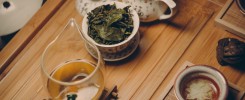As someone who has spent more than twenty years in tea cultivation and trade—from monitoring soil composition in Yunnan tea mountains to evaluating leaf grades at origin—I’ve learned one truth that surprises many: not all tea is good tea. While tea is celebrated for its antioxidants and calming properties, certain types—or more accurately, certain ways tea is produced and consumed—can make it far less healthy than most people realize.
So, what makes a tea “unhealthy”? It’s not about whether it’s black, green, or Pu-erh. It’s about how the tea is grown, processed, stored, and brewed. Let’s break that down from a professional perspective.
Table of Contents
1. Tea Grown with Excessive Chemicals
The biggest health concern in modern tea production isn’t caffeine or tannins—it’s pesticide residue. In large-scale plantations focused on volume rather than quality, chemical fertilizers, pesticides, and herbicides are heavily used to maintain yields.
When I visit lowland industrial tea farms in parts of Southeast Asia or Africa, I often see shallow-rooted bushes in chemically treated soils. These plants absorb residues that can remain in the dried leaves. Once the leaves are brewed, those residues leach into your cup. Over time, consuming such tea regularly can put stress on your liver and kidneys.
A key indicator is price: ultra-cheap teas, especially in supermarket tea bags, often come from bulk commodity sources where chemical control is aggressive. For daily drinking, these are the unhealthiest options—even if they’re labeled “green” or “natural.”
Professional tip: Look for teas that are EU or USDA organic certified, or at least come from regions known for traditional farming methods, such as Yunnan, Fujian, or Darjeeling.
2. “Detox” or “Slimming” Teas: The Marketing Trap
From a business standpoint, I’ve watched the rise of “detox teas” with concern. Many of these blends are not true teas at all—they contain senna, cascara, or other herbal laxatives. These compounds do promote rapid water loss, which gives a temporary illusion of weight loss. But long-term use can cause dehydration, electrolyte imbalance, and digestive dependency.
What’s worse, some of these teas are flavored with synthetic additives to mask bitterness. You’ll find ingredients like “natural flavoring” (a vague label that can hide chemical aroma compounds). As a producer, I know that genuine tea doesn’t need perfume—it has its own aroma if properly processed.
If we define “unhealthiest tea” in terms of how it harms your system over time, then detox teas easily top the list.
3. Over-Fermented or Poorly Stored Teas
Fermentation is an art—and when mishandled, a hazard. I’ve worked with Pu-erh and dark teas long enough to know that microbial balance determines whether a tea ages gracefully or becomes biologically unsafe.
In humid environments without proper airflow, improperly stored teas can develop Aspergillus molds, producing mycotoxins. These are invisible to the eye but detectable through musty or sour odors. I’ve seen collectors lose entire batches of Pu-erh because of careless storage.
If tea is aged in an enclosed or damp area for too long, it stops being a living product and becomes contaminated organic matter. Drinking such tea may cause throat irritation, headaches, or even liver strain.
How to avoid it: Always store tea in a cool, dry, odor-free space. Aged teas should have a clean, earthy fragrance—not a “wet basement” smell.
4. Bottled and Flavored “Teas”: Processed Sugar Traps
Modern tea culture, especially in Western markets, has been overtaken by convenience—ready-to-drink bottled teas, bubble teas, and sweetened blends. These beverages contain little actual tea extract but a high concentration of sugar, preservatives, and acid regulators.
Chemically speaking, these drinks no longer carry the polyphenols and catechins that make real tea beneficial. Instead, they load your system with calories and processed ingredients. They’re closer to soda than to any authentic infusion.
If there’s one type of “tea” I’d never recommend to serious tea drinkers, it’s commercial bottled tea. It misleads consumers into thinking they’re choosing a healthy alternative when they’re not.
5. Brewing Habits That Turn Good Tea Bad
Even high-grade tea can become unhealthy if brewed carelessly. From years of cupping and tasting, I’ve seen how brewing parameters directly affect chemistry:
- Oversteeping black or Pu-erh tea increases caffeine and tannin extraction, leading to stomach upset.
- Using boiling water for delicate green tea destroys catechins and creates astringency.
- Drinking strong tea on an empty stomach can cause acid reflux or dizziness due to caffeine overload.
Good tea is meant to nourish, not stimulate excessively. Brewing correctly—using lower temperatures for green tea and shorter steeps for black and oolong—makes all the difference.
6. The Real Answer
From a professional standpoint, there’s no single “unhealthiest tea” defined by category. Rather, it’s a combination of low-quality raw material, poor agricultural practices, and modern over-processing that makes certain teas harmful.
In short:
- Unhealthy tea = chemically grown + poorly stored + artificially flavored.
- Healthy tea = clean soil + natural processing + mindful brewing.
If you want to safeguard your health while enjoying the true character of tea, invest in quality. Buy from sources that disclose origin and harvest season. Trust your senses—good tea feels alive in aroma and taste.
After all, tea was never meant to be industrial. It was meant to be natural, seasonal, and honest.
Final Thought
The unhealthiest tea is not defined by its color or region—it’s defined by how far it has drifted from nature. True tea is simply the leaf, water, and time in harmony. Once that balance is broken by chemicals, shortcuts, or artificial gimmicks, health and authenticity both disappear.
Choose tea grown with care, processed with respect, and brewed with understanding. That’s not just healthy—it’s the essence of real tea culture.

